- General Information for Residents
- Prefectural Housing
- Employment
- Education
- Traffic
- Disaster Prevention
- Food
- Taxes
- Safety
- Medical and Health Care / Insurance
- Foreign Resident's Guide (Opens in a separate window)
- Aichi Prefecture Medical Information System (PDF:34KB)
- The National Health Insurance (PDF:991KB)
- Differences Between H1N1/09 Influenza (Swine Flu) and Seasonal Flu
- Aichi Cancer Center
- Cancer Incidence in Aichi Prefecture
- AICHI HEALTH PLAZA (Opens in a separate window)
Traffic
Do you know Japan's Traffic Rules?
Japan has traffic rules, set forth under the Road Traffic Act, that automobiles, bicycles, and pedestrians must follow while on the road, and there are penalties for breaking them.
Everyone in your family should learn Japan’s traffic rules to try to avoid getting in accidents.
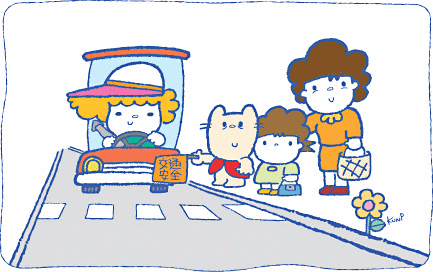
1. Basic Rules
Aichi has a high accident rate, and there are many cases of foreigners as victims as well as offenders.
You should follow the basic traffic rules below, in order to avoid getting in accidents.
- Pedestrians should walk on the right side of the road, while automobiles and bicycles should travel on the left side.
- Between automobiles and pedestrians, pedestrians get right-of-way.
- You should obey all traffic signals and road signs.
- You should follow any instructions given by police officers.
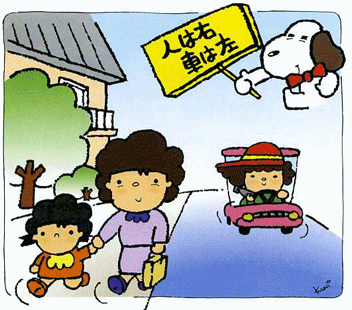
2. Basic Rules for Pedestrians
- Pedestrians should stay on the sidewalk wherever there is one.
- Where there is no sidewalk, pedestrians should walk on the right side of the road.
-
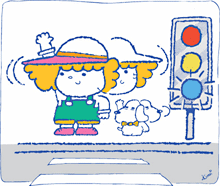 Pedestrians should follow the pedestrian signals when crossing at an intersection that has traffic lights. When crossing at an intersection without traffic lights, use the crosswalk.
Pedestrians should follow the pedestrian signals when crossing at an intersection that has traffic lights. When crossing at an intersection without traffic lights, use the crosswalk.
- Pedestrians should take overhead and underground pedestrian walkways when they are available.
-
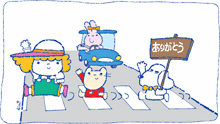 Pedestrians should look both ways and make sure there are no vehicles nearby, or that nearby vehicles are stopped, when crossing the street.
Pedestrians should look both ways and make sure there are no vehicles nearby, or that nearby vehicles are stopped, when crossing the street.
- Even when crossing a crosswalk at a green light, pedestrians should take care to watch for vehicles making right or left turns.
- Never dash out into the street.
- Do not play in the street.
-
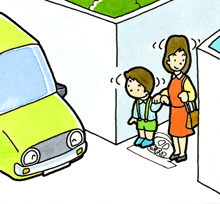 When crossing a street with poor visibility, first stop and look both ways to make sure it is safe.
When crossing a street with poor visibility, first stop and look both ways to make sure it is safe.
- Before crossing a railway crossing, first stop and look both ways to make sure it is safe.
-
 When going out at night, it’s a good idea to wear brightly colored or reflective clothing.
When going out at night, it’s a good idea to wear brightly colored or reflective clothing.
3. Basic Rules for Bicycles
In 2008, about 27% of accidents involving injury or death in which the victim or offender was a foreigner were accidents involving bicycles.
Please be aware of the following when riding a bicycle.
- Riding a bicycle on the road is the norm, and on the sidewalk is the exception.
You may ride on the sidewalk in the following instances.- When street signs indicate that a sidewalk is for both pedestrian and bicycle use
- When the bicycle is being ridden by infants, children, senior citizens of age 70 or older, or people with physical disabilities
- When road conditions (such as construction or illegally parked vehicles) make it necessary to use the sidewalk
-
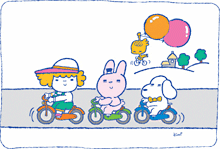 Bicycles should keep to the left edge of the road.
Bicycles should keep to the left edge of the road.
-
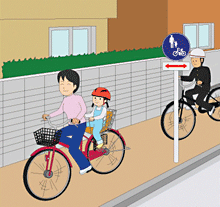 Bicycles may use sidewalks that have signs indicating they are for both pedestrian and bicycle use, but they should be ridden more slowly on sidewalks than on the road.
Bicycles may use sidewalks that have signs indicating they are for both pedestrian and bicycle use, but they should be ridden more slowly on sidewalks than on the road.
- On the sidewalk, pedestrians have right-of-way.
- Riding a bicycle while under the influence of alcohol is prohibited.
-
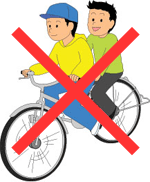 Riding double on a bicycle is prohibited.
Riding double on a bicycle is prohibited.
-
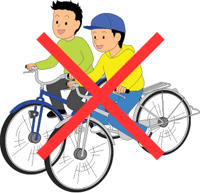 Riding in parallel with other bicycles is prohibited.
Riding in parallel with other bicycles is prohibited.
- You should use a headlight when riding at night.
- You should obey the traffic lights at intersections, and always briefly stop to make sure it is safe before proceeding.
- You should not talk on your cell phone while riding a bicycle.
-
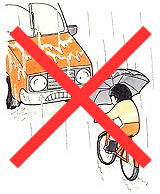 You should not hold an umbrella while riding a bicycle. Wear a raincoat instead.
You should not hold an umbrella while riding a bicycle. Wear a raincoat instead.
-
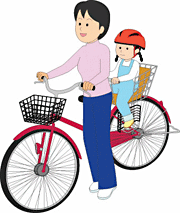 Children and infants who are riding as passengers with a parent on a bicycle should wear bicycle helmets.
Children and infants who are riding as passengers with a parent on a bicycle should wear bicycle helmets.
4. Basic Rules for Automobiles
In 2008, about 60% of accidents involving injury or death in which the victim or offender was a foreigner were accidents involving automobiles.
Please be aware of the following when driving an automobile.
-
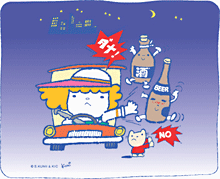 Driving an automobile is strictly prohibited for those who do not have a driver’s license and those who are under the influence of alcohol.
Driving an automobile is strictly prohibited for those who do not have a driver’s license and those who are under the influence of alcohol.
- You should obey all traffic rules, traffic lights, road signs and road indicators.
-
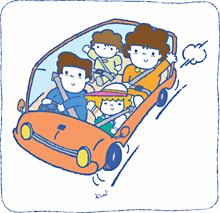 Ensure that all passengers fasten their seatbelts when riding in an automobile. When riding a scooter, be sure to wear a helmet.
Ensure that all passengers fasten their seatbelts when riding in an automobile. When riding a scooter, be sure to wear a helmet.
-
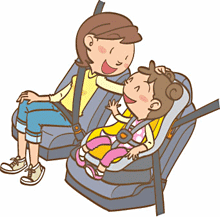 Children younger than 6 years of age should sit in an infant car seat when they are in an automobile.
Children younger than 6 years of age should sit in an infant car seat when they are in an automobile.
-
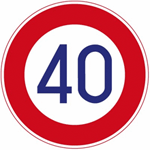 Do not exceed that maximum speed limit that is posted on street signs or other traffic indicators.
Do not exceed that maximum speed limit that is posted on street signs or other traffic indicators.
- When coming to an intersection with poor visibility, you should stop briefly and look both ways to make sure it is safe before proceeding.
- You must not disrupt the flow of oncoming traffic when making a right-hand turn. You should also watch for pedestrians crossing the street when making a right-hand turn.
- Pedestrians crossing the street at a crosswalk have right-of-way. Always be sure to check for pedestrians crossing the street. If there are any, be sure to stop and wait for them.
-
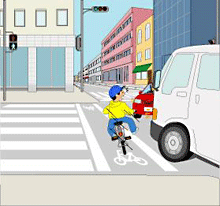 When making a left-hand turn, you should watch out for motorcycles and bicycles to your left that are continuing straight in order to avoid problems. You should also watch out for pedestrians crossing the street.
When making a left-hand turn, you should watch out for motorcycles and bicycles to your left that are continuing straight in order to avoid problems. You should also watch out for pedestrians crossing the street.
- Try to be prompt in turning on your headlights when the sun starts to set.
- Do not use a cell phone while driving.
-
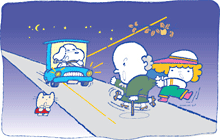 Many traffic accidents involve elderly drivers. If you notice an elderly driver, try to reduce your speed and drive with consideration for the other vehicle.
Many traffic accidents involve elderly drivers. If you notice an elderly driver, try to reduce your speed and drive with consideration for the other vehicle.
5. Vehicle Breakdowns at Railway Crossings
If you are at a railway crossing and your automobile stalls, you must immediately take the following action in order to alert train engineers. You must also move your vehicle off of the crossing.
-
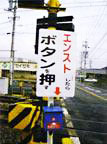 Alert oncoming trains by pushing the emergency button on the crossing breakdown alert box that is installed on alarm posts.
Alert oncoming trains by pushing the emergency button on the crossing breakdown alert box that is installed on alarm posts.
- Set off a flare if your vehicle is equipped with any, in order to alert oncoming trains.
- If you don’t have any flares, find something nearby that is easy to burn and set it on fire in order to alert oncoming trains.
6. What to Do if an Accident Occurs
If you happen to get in an accident, remain calm and carry out the following instructions.
- Move the vehicle to a safe location to avoid blocking traffic, and turn off the engine.
- If anyone is injured, call the fire department (dial 1-1-9). While waiting for an ambulance or medical help to arrive, try to staunch the flow of blood using gauze or a handkerchief as a temporary measure.
- Call the police (dial 1-1-0) and inform them of the location of the accident as well as the number of people injured and the extent of the injuries.
- If no one is hurt, wait at the scene of the accident until the police arrive.
- If you cause a traffic accident, you may be liable for civil damages. In addition, you will face administrative punishment (such as the suspension or loss of your driver’s license) and other penalties (such as fines). Traffic accidents can hurt not only you, but your friends and loved ones as well, so do your best to drive safely and avoid causing accidents.
7. How to Place Emergency Phone Calls
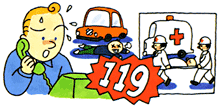 (1) Injuries (1-1-9)
(1) Injuries (1-1-9)
If someone is injured, you should call 1-1-9 to report it. You can call 1-1-9 at any time of day, anywhere in Japan, for free.
How to place your call:- Dial 1-1-9 directly without any dialing prefix or area code. If you are using a public pay phone, firmly press the red emergency button.
- Clearly inform the operator about the injury, and tell the operator your location and name.
Kega o shimashita. (Someone's been injured.)
Basho wa (say your location) desu. (My location is .)
Watashi wa (say your name) desu. (My name is .)
If a traffic accident occurs, call 1-1-0 to report it. You can call 1-1-0 at any time of day, anywhere in Japan, for free.
How to place your call:- Dial 1-1-0 directly without any dialing prefix or area code.
- Accurately inform the operator what has happened, as well as where and when, and tell the operator your name, in Japanese.
(say the hour) ji, (say your location) de kotsu jiko ga arimashita. (An accident occurred at the location at o'clock.)
Watashi wa (say your name) desu. (My name is .)
Renraku saki wa (say your phone number) desu. (My phone number is .)
8. Driver’s Licenses
In order to drive an automobile in Japan, you need to have either a driver’s license issued in Japan or an international driver’s license issued by a country that is a signatory to the Geneva Convention on Road Traffic.
(2) Getting a Driver’s License in JapanDepending on the type of license you’re getting, a temporary license will be necessary, and you will have to take both a knowledge test (generally in Japanese, but available upon request with furigana or in English) and a skills test (which requires you to converse in Japanese). You will need to study Japanese traffic rules in advance in order to take the tests.
For reference, a traffic manual (available in Japanese, English, Chinese, Portuguese, Spanish, and Korean) can be purchased from the Japanese Automobile Federation (JAF). Their phone number is 052-872-3867.
(3) Replacing a Foreign Driver’s License with a Japanese LicenseIf you meet the following criteria, you can apply to have your foreign driver’s license replaced with a Japanese license at the Aichi Driver’s License Test Site (TEL: 052-801-3211, Address 3-605 Hirabariminami, Tenpaku-ku, Nagoya) or the Higashi-Mikawa Driver’s License Center (TEL: 0533-85-7181, Address 2-7 Kanayanishi-cho, Toyokawa).
- You possess a valid driver’s license from a foreign country.
- You lived in the issuing country for at least three months.
- You pass a knowledge and driving skills test.
After inspecting your documents at the time of application, a driver’s license will be issued to you if you pass an examination of your aptitude, knowledge, and (on the following day) driving skills. (Some countries are exempted from the knowledge and skills examination.)
- Required Documents
- Your foreign driver’s license and photocopies of both front and back
- A Japanese translation of your foreign driver's license (which can be acquired from the government, embassy, or consulate of the issuing country, or through the main Chubu office of the Japan Auto Federation [JAF] or one of its branch offices [TEL: 052-872-3685])
- Photocopies of the pages from your current and expired passports with your photo, passport expiry date, and visa
- Photocopies of both sides of your alien registration card (or in the case of Japanese citizens, a photocopy of your certificate of residence with your address in Aichi as recorded in the family register)
- One driver's license photograph (a photo of you from the chest up from the front, wearing no hat, with a plain background, taken within 6 months prior to the time of application)
Photo dimensions: 3 cm tall, 2.4 cm wide - A processing fee, which will vary according to the type of license you are replacing
- A photocopy of your personal ID
- A driving record certificate for your foreign license is required
- Note 1: Those who don’t know Japanese or who are unable to fill out the application paperwork should bring a companion to translate.
- Note 2: The documents you need to include may differ according to country. For specifics, contact the Aichi Driver’s License Test Site or the Mikawa Driver’s License Center directly.
- Note 3: The consulate of the Federal Republic of Brazil in Nagoya
The initial driver’s license you are issued with expires one month after your third birthday following its issuance. (If your license lapses, you are no longer licensed or able to drive an automobile.) Afterwards, depending on the length of time you’ve had your license and any violations against it, you can attend a class to renew your driver’s license and extend the expiry date by 3 or 5 years. The renewal procedure can be carried out the Aichi Driver’s License Test Site and the Mikawa Driver’s License Center, as well as at local police stations that provide license renewal services. (The public safety commission sends license holders renewal notices on an individual basis with instructions regarding which locations that an individual’s license can be renewed at.)
- Required Documents
- Your renewal notice (postcard) and your driver’s license (or driver’s license suspension documents for those who have had their licenses suspended)
- Proof of your new address if your address has changed (foreigners may provide their alien registration cards or health insurance cards)
- Photocopies of your alien registration card if your name or nationality has changed
- The processing fee (good drivers: ¥3,250; ordinary drivers: ¥3,600; drivers with violations and first-time renewers: ¥4,250; senior citizens: ¥2,550 (with a separate fee for seniors taking driving classes at a designated driving school: ¥5,800 for ages 70–74, and ¥6,000 for ages 75 and up)
9. Automobile Insurance
As a precaution against automobile accidents, we recommend purchasing the optional liability insurance in addition to mandatory auto insurance.
(1) Mandatory Insurance (Automobile Liability Insurance)Those who own an automobile, motorcycle or scooter are required to purchase this insurance by law. This insurance will be included when you purchase a vehicle or get a vehicle inspection done. The insurance policy is processed by an agent of the liability insurer at the auto dealer or repair shop.
(2) Optional InsuranceThis insurance covers vehicle and passenger liability damages that are not covered by mandatory insurance, as well as insurance claims that exceed the payout limits of mandatory insurance policies in the case of accidents.








